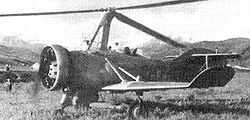ZAGI A-7
| ZAGI A-7 | |
|---|---|

|
|
| Type: | Gyroplane |
| Design country: | |
| Manufacturer: | |
| First flight: |
September 20, 1934 |
| Commissioning: |
1938 (?) |
| Number of pieces: |
5 |
ZAGI A-7 ( Russian ЦАГИ А-7 , also ZAGI 7-EA , ЦАГИ 7-ЄА) was a Soviet gyroplane from the 1930s. It was developed by Nikolai Kamow , who became famous in later years for the helicopter designs of the Kamow design office named after him . A stands for Avtozhir (Автожир), gyroplane or autogiro.
development
In 1930, the Central Aerohydrodynamic Institute (ZAGI) established a department for the construction of gyroscopes, in which several well-known helicopter designers were involved, such as Ivan Bratuchin , Boris Jurjew and Michael Mil . In the same year, the first helicopter design 1-EA appeared . In 1931 the construction of the first 2-EA gyroplane was completed. Building on this experience, the development of a military gyroplane for reconnaissance and artillery observation with the designation 7-EA was advanced in the same year.
The first flight of the prototype took place on September 20, 1934 by S. A. Korsinschtschikow as A-7. The subsequent flight test, which lasted over a year, was completed on December 9, 1935. It revealed some defects in the tail unit and the rotor, whereupon the model was thoroughly revised. In the meantime, the gyroplane was presented to the public by K. K. Popow on August 18, 1935 at the 3rd Tushino Air Parade. The repeated tests were carried out satisfactorily from May 1937 to July 1938 under the designation A-7bis (bis = Russian for "once more"). As an experiment, the A-7 was taken by train to Kronstadt and there loaded onto the “ Jermak ” icebreaker , which then left to evacuate the Papanin polar station . However, since the expedition had previously been saved by the "Taimyr", the planned mission could not take place under arctic conditions.
A small series comprising five machines was then produced. A civilian use took place in the agricultural sector to spray chemicals over forests as well as during a geological expedition in Tien-Schan . After the outbreak of war between the German Reich and the Soviet Union, the A-7s were grouped under the designation A-7-3a in a squadron under the command of P. G. Trofimow near Smolensk and were intended to be used for reconnaissance flights and to drop leaflets. Michail Mil, who had been involved in the development, also served there as chief engineer. At the end of August 1941, the squadron moved to the Jelna area. Operations flown there only took place at night, as the relatively slow autogiros were an easy target for enemy fighters.
technical description
The A-7 consisted of a fabric-covered, three-part fuselage construction made of wood with braced wings in a low- wing arrangement and ends angled upwards, as well as a tail unit that was also braced. The tailplane was set high and there were stabilizing surfaces on its underside. The landing gear was rigid and designed in the stern, later in the nose wheel configuration. Skis could be mounted. The rotor was on a frame in front of the crew cabins and had three leaves.
Technical specifications
| ZAGI A-7bis | ЦАГИ А-7бис |
|---|---|
| Manufacturer | ZAGI |
| Constructor (s) | Nikolai Kamov |
| crew | 2 |
| Rotor circle diameter | 15.2 m |
| Empty mass | 1300 kg |
| Takeoff mass | 2056 kg |
| drive | an air-cooled 9-cylinder radial engine M-22 |
| Starting power | 355 kW (483 hp) |
| Top speed | 210 km / h |
| Minimum speed | 46 km / h |
| Summit height | 4800 m |
| Take-off / landing route | 30 m / 20 m |
literature
- Wladimir B. Kazakow: perpendicular to the sky , aviator calendar of the GDR 1989, ISBN 3-327-00520-6 .
Web links
Individual evidence
- ^ Karl-Heinz Eyermann , Wolfgang Sellenthin: The air parades of the USSR. Central Board of the Society for German-Soviet Friendship, 1967. p. 32.
- ↑ Wilfried Copenhagen : The helicopters of Nikolai Iljitsch Kamow , in Flieger Jahrbuch 1984, Transpress, Berlin 1984, p. 58.